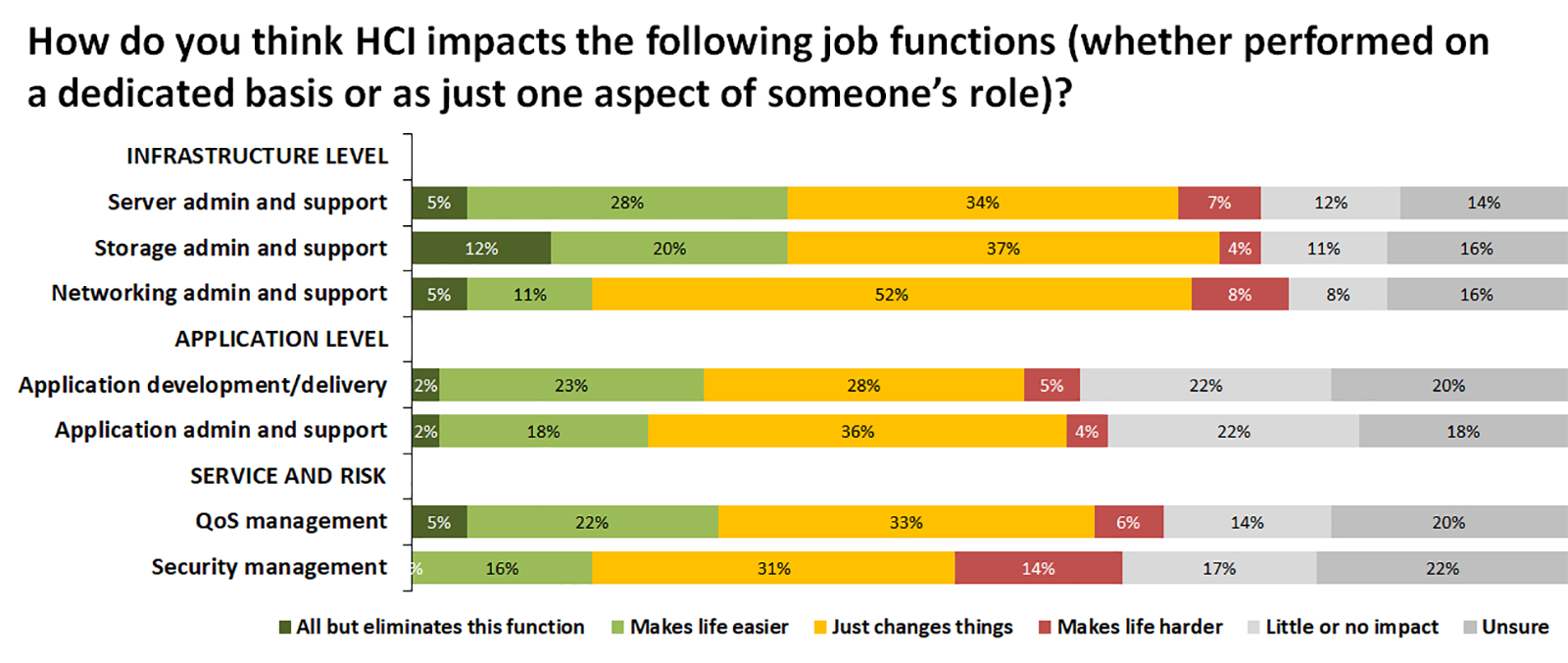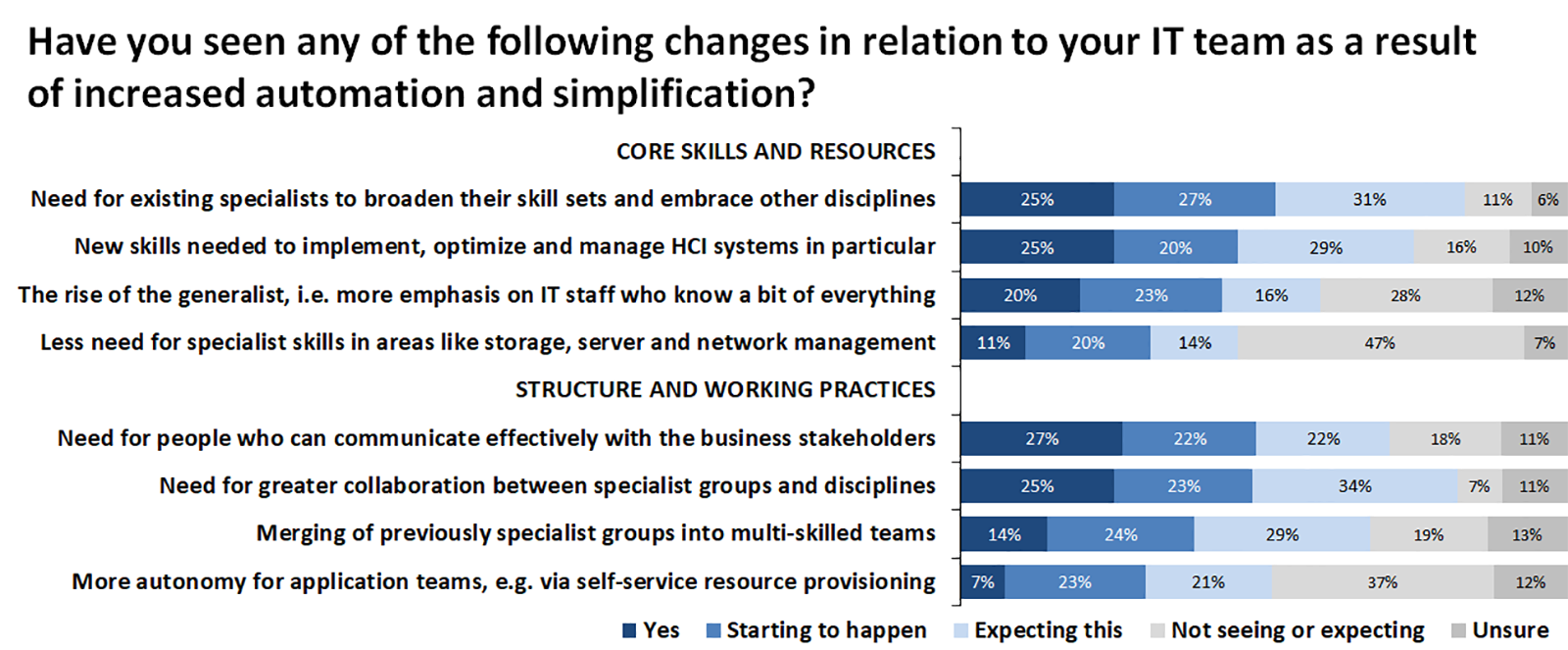It’s not just about platform automation
In a nutshell
Many IT teams are dogged by infrastructure complexity and heavy reliance on manual processes and home-grown scripts. Newer technology options such as hyperconverged infrastructure can help to simplify and inject more automation into the IT systems environment. But this has knock-on effects in terms of skills requirements and the nature of future operations work, and both IT leaders and practitioners at the sharp-end need to be prepared.
Complexity and the impossible dream
As you look around your datacenter, the chances are that your eyes will be met by a lot of complexity. Some of it will reflect the differing needs of the applications and workloads you run, each of which may mandate a specific systems-stack, configured in a specific manner. But beyond this, within any individual category of hardware or software, you’ll likely find equivalent components from multiple manufacturers that often span a number of classes and technology generations. Whether it’s servers, storage devices, database management systems or any other element of infrastructure, a mixture of hardware and software just accumulates over time as the new gets provisioned, but the old rarely gets switched off and disposed of.
Put this together with integration requirements (few systems operate in isolation), and the fact that tooling often seems to be lacking, and the result for many IT teams is a whole range of challenges, that in turn often undermine their ability to meet business needs and expectations (Figure 1).

The chart we see here comes from a recently conducted survey of 83 American readers of The Register (www.theregister.co.uk). While a few respondents say that everything is fine, most are suffering to some degree, many quite badly.
Against this background, the prevailing and quite telling view is that if IT pros could build again from scratch, their infrastructure wouldn’t look the way it does today.
Steps to simplify and automate
Totally eradicating infrastructure complexity is a pipe-dream in most IT environments. That said, you certainly don’t want to add to it, and where you can, it makes sense to simplify things, which in turn eases the path to automation.
A technology presenting some interesting opportunities here is hyperconverged infrastructure (HCI). The idea is to pool a set of systems resources, e.g. servers, storage devices, network equipment, etc, into a consistent platform layer, then exploit smart software to manage how resources are used in an automated manner, providing access to capacity via a standards-based virtualization layer.
It’s beyond the scope of our discussion here to go into detail of how HCI works. Suffice it to say for now that the end result is a highly simplified, flexible and self-optimizing scale-out systems-platform able to simultaneously support a mixed set of workloads with a variety of resource and quality of service needs. If this sounds a bit like a private cloud, that’s no coincidence. Indeed, it’s becoming more common to hear suppliers using terms like ‘HCI’ and ‘Enterprise Cloud Platform’ interchangeably.
But is the potential of taking these kinds of platforms on board to simplify and automate starting to be recognized among IT professionals?
The short answer is ‘yes’. Back to our survey sample, just under 30% told us they had already adopted HCI, with a further third saying they were currently evaluating or had HCI on their agenda to explore (Figure 2).

The obvious next question is whether the early adopters we see here confirm the role and value of HCI in the real world.
We didn’t have enough respondents in our survey to explore this question in a statistically rigorous manner, but despite the limitations, a striking correlation emerged from the data that represents a very strong indicator. It’s probably no coincidence that those with direct production experience of HCI systems were 3 to 4 times more likely to regard hyperconverged infrastructure as either a core transformational technology or an important enabler in key areas (Figure 3).

The variation in views reflects the journey the industry has been on with HCI. Early incarnations of the technology came with significant constraints and limitations, and were often positioned as primarily storage solutions. This led to a combination of skepticism and pigeon-holing, and those initial perceptions have lingered in the minds of some IT pros. Related to this, the negative or unsure view expressed by some (albeit very few) adopters could be down to mixed experiences with early offerings.
Against the backdrop of highly capable modern HCI platforms, we can sum up this picture as highlighting the need for suppliers to double-down on their market education efforts. The evidence suggests that HCI represents at least one effective option for driving greater simplicity and automation into the systems environment.
Implications for key IT functions and roles
While this positive high-level view will be of comfort to senior managers, a big question if you work at the sharp-end is how solutions such as HCI are likely to impact your daily activities. On this matter, the survey revealed a prevailing view that HCI can be expected to change many aspects of operations and support, even though there’s no clear consensus on exactly how (Figure 4).

Again, while we haven’t shown it explicitly, the data behind the above chart tells us that HCI adopters are more likely to have a positive view of the impact, i.e. to say that often tedious functions are eliminated or made easier. However, the correlations are not as strong as the one we saw earlier because a couple of other factors are at play.
Firstly, that shiny new HCI environment may well simplify or eliminate certain administration tasks, but it still represents yet another way of doing things, and if deployed alongside rather than replacing existing systems, could arguably be considered as adding to the overall level of complexity. Secondly, your perception of how HCI impacts a specific area can be influenced by the job you do. Someone who needs to provision and manage storage, but is not a specialist in the area, may take the view that HCI makes life a lot easier. A storage expert, meanwhile, may (rightly or wrongly) perceive a lack of visibility and control, and worry, for example, that this will make troubleshooting harder. Another option is that they don’t think things will be better or worse, but simply that different approaches and processes will be required.
It’s impossible to unravel all of these influencing factors, but if we zoom out to the bigger picture, the one thing for certain is that increased automation and simplification in general is already disrupting the status quo in a number of different ways (Figure 5).

The survey stats we see here highlight some clear takeaways and imperatives, and these were reinforced by the comments we captured during the study in respondents’ own words. In answer to the open question “What do you say to those who see automation as a way to deskill IT or threaten traditional IT operations roles?”, we received a range of interesting and enlightening responses.
Firstly, addressing the huge elephant in the room, almost no one participating in the study saw automation as a catalyst for IT team downsizing. The overwhelming view was more one of IT staff having the opportunity to refocus their time and efforts on more interesting and valuable activities:
“Automation takes the drudge out of everyone’s life and allows IT to better align with the business and become an enabler.”
“It’s about more time to focus on value added projects for the business.”
“We have an opportunity to re-deploy resources for higher level value add.”
“Automation frees your time from grunt work, so use it to improve systems or develop new features, or to learn new skills for your next job.”
The reference to new skills in that last comment underlines some important shifts in emphasis that are taking place in this area. Sometimes these are technology-related, other times it’s more about the people and business dimensions:
“Time spent on physical server admin was reduced with virtualization, but then managing the hypervisor became an important new skill.”
“We will just become automation experts, coding infrastructure.”
“Someone still needs to understand what is going on in the black box. It will always break in some shape or form that needs fixing.”
“You still need people who can translate requirements into technology.”
“Up-skilling in soft skills is desperately required.”
But there’s no doubt that that if your job currently revolves around activities that are likely to be reduced or eliminated by the march of automation, even if you have a very deep and specialised skill-set, then you need to take steps to stay relevant:
“I’ve been working on systems automation since the 1980s. It has eliminated roles and created others. And yes there is pain during transition, especially for people who cannot or will not change their skills or ways of doing things.”
“Automation doesn’t deskill IT, but it does threaten traditional IT roles, no matter how specialized those older roles are.”
We don’t have room to list all of the other comments here; suffice it to say that much of the feedback netted out to an over-arching imperative for IT professionals to extend and broaden their skill-sets, and for IT leaders to help facilitate this. One respondent summed it up quite nicely in one of our favorite comments:
“Cowboy Up! In this day and age we need to continually update our skills.”
If you take only one thing away from this research, this message should probably be it.
The Bottom Line
In the context of complexity-busting and IT ops automation, hyperconverged infrastructure is acknowledged to represent an interesting and relevant solution to some significant traditional problems. Indeed, those with experience of modern HCI systems appreciate the value.
As IT teams use HCI and other solutions to simplify and automate their environments, however, a key question is how much traditional structures, processes and roles will be affected. Our survey suggests quite a bit, and while the pace of change will vary, it’s likely a case of ‘when’ rather than ‘if’ some of the changes highlighted above will take place in your organization. With this in mind, there’s a call to action for both IT leaders and practitioners to consider the impact of further automation and prepare sooner rather than later if they haven’t done so already.
Dale is a co-founder of Freeform Dynamics, and today runs the company. As part of this, he oversees the organisation’s industry coverage and research agenda, which tracks technology trends and developments, along with IT-related buying behaviour among mainstream enterprises, SMBs and public sector organisations.





Have You Read This?
From Barcode Scanning to Smart Data Capture
Beyond the Barcode: Smart Data Capture
The Evolving Role of Converged Infrastructure in Modern IT
Evaluating the Potential of Hyper-Converged Storage
Kubernetes as an enterprise multi-cloud enabler
A CX perspective on the Contact Centre
Automation of SAP Master Data Management
Tackling the software skills crunch